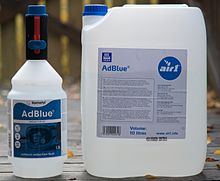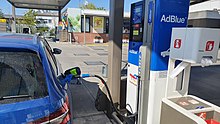Diesel exhaust fluid (DEF; also known as AUS 32 and marketed as AdBlue[3]) is a liquid used to reduce the amount of air pollution created by a diesel engine. Specifically, DEF is an aqueous urea solution made with 32.5% urea and 67.5% deionized water. DEF is consumed in a selective catalytic reduction (SCR) that lowers the concentration of nitrogen oxides (NO
x) in the diesel exhaust emissions from a diesel engine.[4]



Other names edit
In the international standard defining DEF (ISO 22241), it is referred to as AUS 32 (aqueous urea solution 32%).[5] DEF is also sold as AdBlue, a registered trademark of the German Association of the Automotive Industry.
Several brands of SCR systems use DEF: BlueHDI is used by PSA Group vehicles including Peugeot, Citroën, and DS Automobiles brands; BlueTec by Daimler AG; and FLENDS (Final Low Emission New Diesel System) by UD Trucks. Blue Sky DEF is made and distributed for retail sale by Prime Lubes, Inc.[6]
Background edit
Diesel engines are typically operated with a lean burn air-to-fuel ratio (over-stoichiometric ratio) to ensure the full combustion of soot and to prevent them from exhausting unburnt fuel. The excess air leads to the generation of NO
x, which are harmful pollutants, from nitrogen in the atmosphere. SCR is used to reduce the amount of NO
x released into the atmosphere. DEF from a separate tank is injected into the exhaust pipeline, and the exhaust heat decomposes it to ammonia. Within the SCR catalyst, the NO
x are reduced by the ammonia into water and nitrogen, which are both nonpolluting. The water and nitrogen are then released into the atmosphere through the exhaust.[7]
SCR was applied to automobiles by Nissan Diesel Corporation, and the first practical product "Nissan Diesel Quon" was introduced in 2004. With the cooperation of the oil and chemical industry, a 1,300-station infrastructure to supply DEF was prepared by September 2005 in Japan.[8]
In 2007, the United States Environmental Protection Agency (EPA) enacted requirements to significantly reduce harmful exhaust emissions. To achieve this standard, Cummins and other diesel engine manufacturers developed an aftertreatment system that includes the use of a diesel particulate filter (DPF).
As the DPF does not function with low-sulfur diesel fuel, diesel engines that conform to 2007 EPA emissions standards require ultra-low-sulfur diesel (ULSD) fuel to prevent damage to the DPF. After a brief transition period, ULSD fuel became common at fuel pumps in the United States and Canada.
The 2007 EPA regulations were meant to be an interim solution to allow manufacturers time to prepare for the more stringent 2010 EPA regulations, which reduced NO
x levels even further.[9] In 2008, the concerns about compliance shifted to the infrastructure for DEF distribution.[10]
The injection rate of DEF into the exhaust depends on the specific after-treatment system, but is typically 2–6% of diesel consumption volume. This low dosing rate ensures long fluid refill intervals and minimizes the tank's size and intrusion into vehicle packaging space. An electronic control unit adjusts the addition of fluid in accordance with parameters such as NO
x level in the exhaust gas (before catalytic converter, after catalytic converter, and possibly between catalytic converters if there is more than one), current ammonia filling level,[11] engine operating temperature and speed.[citation needed]
Chemistry edit
DEF is a 32.5% solution of urea, (NH
2)
2CO. When it is injected into the hot exhaust gas stream, the water evaporates and the urea thermally decomposes[12] to form ammonia (NH
3) and isocyanic acid (HNCO):
- (NH
2)
2CO → NH
3 + HNCO
The isocyanic acid reacts with the water vapor and hydrolyses to carbon dioxide and ammonia:
- HNCO + H2O → CO2 + NH
3
Overall, thus far:
- (NH
2)
2CO + H
2O → 2 NH
3 + CO2
Ammonia, in the presence of oxygen and a catalyst, reduces two different nitrogen oxides:[13]
- 4 NO + 4 NH
3 + O
2 → 4 N
2 + 6 H2O ("standard SCR") and - 6 NO
2 + 8 NH
3 → 7 N
2 + 12 H2O ("NO2 SCR selective catalytic reduction") [citation needed] - NO + NO
2 + 2 NH
3 → 2 N
2 + 3 H
2O ("fast SCR")
The overall reduction of NO
x by urea is then:
- 2 (NH2)2CO + 4 NO + O2 → 4 N2 + 4 H2O + 2 CO2 and
- 4 (NH2)2CO + 6 NO2 → 7 N2 + 8 H2O + 4 CO2 and
- (NH2)2CO + NO + NO2 → 2 N2 + 2 H2O + CO2
The ratio between NO2 and NO determines which reactions take place and how fast. The highest conversion rates are achieved if equal amounts of NO2 and NO are present, especially at temperatures between 200 °C and 350 °C. If there is more NO than NO2, fast SCR and standard SCR take place sequentially. If there is more NO2 than NO, fast SCR and NO2 SCR take place sequentially, however, NO2 SCR is slower than standard SCR, and ammonium nitrate can form and temporarily deactivate the catalytic converter.[14]
Operation in winter time edit
DEF freezes at −11 °C (12 °F).[15][16][17] For the SCR exhaust cleaning system to function at low temperatures, a sufficient amount of the frozen DEF must be melted in as short time as possible, preferably on the order of minutes. For example, 2010 EPA emissions requirements require full DEF coolant flow within 70 minutes.[18][19]
In Europe, Regulation (EC) No 692/2008[20] specified in Annex XVI point 10 that DEF from a frozen tank at a core temperature of −15 °C (5 °F) must become available within 20 minutes when starting the engine at −15 °C (5 °F).
Typically, the frozen DEF is melted by heat from the engine, e.g. engine coolant passing through the DEF tank, governed by a thermostatic coolant control valve. This method may take significant time before the SCR exhaust cleaning system is fully operational, often up to an hour.[4]
Another method to thaw DEF (and thus allow for full SCR operation) is to integrate an electric heater into the DEF tank. This heater must be sized, positioned, and powered adequately to rapidly melt sufficient frozen DEF. It should preferably be self regulating not to overheat if (part of) the heater is outside of the liquid. It should also preferably be self regulating to eliminate any complicated sensor and temperature regulating systems. Furthermore, the heater should not exceed 50–60 °C (122–140 °F), as DEF begins to decompose at around 60 °C (140 °F). PTC heaters are often used to achieve this.
Safety and storage edit
The urea solution is clear, non-toxic and safe to handle.[21] Since urea has corrosive impact on metals like aluminium, DEF is stored and transported in special containers.[22][23] These containers are typically made of stainless steel.[23] Vehicles' selective catalytic reduction (SCR) systems and DEF dispensers are designed in a manner that there is no corrosive impact of urea on them.[22] It is recommended that DEF be stored in a cool, dry, and well-ventilated area that is out of direct sunlight. Bulk volumes of DEF are compatible for storage within polyethylene containers (HDPE, XLPE), fiberglass reinforced plastic (FRP), and steel tanks. DEF is also often handled in intermediate bulk containers for storage and shipping.
DEF is offered to consumers in a variety of quantities ranging from containers for single or repeated small usage, up to bulk carriers for consumers requiring a large amount of DEF. As of 2013, many truck stops have added DEF pumps. These are usually adjacent to fuel pumps so the driver can fill both tanks without moving the truck.
In Europe, increasing numbers of fuel stations offer AdBlue pumps, not only for large commercial vehicles but also for passenger cars.
At airports, where DEF can sometimes be required for diesel ground service vehicles, its labelling and storage must be carefully managed to avoid accidentally servicing jet aircraft with DEF instead of fuel system icing inhibitor, a mistake that has been blamed for multiple in-flight engine failure and grounding incidents.[24][25][26]
Supply shortage edit
South Korea edit
As of December 2021[update], a shortage of DEF in South Korea was continuing and brought havoc to its economy. As most of the urea used is supplied by China, imports have slowed since China introduced mandatory inspections of urea exports in September. [27]Nearly 97% of South Korea's urea imports came from China between January and September. In 2015, South Korea had made it mandatory for diesel cars to use urea solutions to control emissions, a move that now impacts 40% of registered vehicles. Diesel vehicles made since 2015 were required to be fitted with SCR systems.[28] The South Korean government started rationing urea solution, and banned its resale as panic buying by drivers exacerbated an acute shortage that could cause transport and industry to grind to a halt.[29] A KC-330 Cygnus was sent to import Diesel exhaust fluid from Australia to ease a supply shortage of the key material used in diesel vehicles.[30]
Australia edit
In early December 2021, the Australian National Road Transport Association also raised concerns about a shortage of DEF in the country due to the shortage of urea in China.[31] China capped exports to protect its domestic supplies and rising DEF prices. By mid-December there was approximately 7 weeks’ supply of AdBlue left in Australia.[32]On 14 December, an Australian company stated that it would build a new plant.[33]